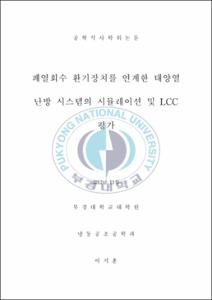폐열회수 환기장치를 연계한 태양열 난방 시스템의 시뮬레이션 및 LCC 평가
- Alternative Title
- A Simulation and LCC Evaluation of Solar Heating System using
- Abstract
- Korea in 2008, is the world's nine largest energy consuming countries, greenhouse gas emissions the world's 11th rank. Since the 1993 that joined United Nations Framework Convention on Climate Change, in 2002 Deviated from obligations to reduce greenhouse gas emissions in 2002. However, according to the agreement in Copenhagen should be reduced to 30% in 2020 Business As Usual. This is a recommendation based on IPPC(Intergovernmental Panel on Climate Change) in developing countries is the highest level. As a result, reduces to that our dependence on fossil fuels and carbon emissions the government was planning a green growth. In addition, while experiencing the need for introducing a carbon tax, as the solution to this problem is increasing interest in renewable energy sources. Renewable energy sources currently being developed country for practical application is solar energy and wind power. Biomass, geothermal, ocean energy, fuel cells use for energy that development in some areas, or put in front of commercialization. Of solar energy resources consistent with the current technological and economic advance continues, one of the most widely used renewable energy sources. Technology that uses solar energy for the solar heat energy and solar photovoltaic can be divided into two kinds of technology. Use of these technology, heating or cooling in building, hot-water supply and supply heat to processes. In this study, we use solar heat energy to heat building for heating system was studied. As the experimental site was the S corps actual workplace. In addition, the industry requires large amounts of energy consumption, occur harmful substances that threaten worker's health during the operation, considering that the heat recovery ventilation system was installed. We stored solar thermal energy to storage tank through solar collectors. Heat recovery ventilator exchange heat between return air and outdoor air. The outdoor air that is heat exchanged sent to air-handling unit, and heated by solar thermal energy stored in storage tank. Heated air is supplied to indoor room through air-handling unit. In this study, we proceed Simulation and LCC evaluation. As a result we Investigate the performance of Heat recovery ventilator, and were able to determine the economics of the solar system.
Temperature was a big impact on the efficiency of the Heat recovery ventilator. A daily amount of heat recovery is 14,370 kcal/h, The amount of the accumulate heat recovery is 4,140,100 kcal.
The result of Life Cycle Cost, Solar system had occurred 14 years later, the cost savings for the boiler system and EHP.
- Issued Date
- 2013
- Awarded Date
- 2013. 2
- Type
- Dissertation
- Publisher
- 부경대학교
- Alternative Author(s)
- Lee, Ji Hoon
- Affiliation
- 부경대학교 대학원
- Department
- 대학원 냉동공조공학과
- Advisor
- 금종수
- Table Of Contents
- 제1장 서론 1
1.1 연구 배경 1
1.2 연구 목적 3
제2장 태양열 난방 시스템 4
2.1 시스템계통도 4
2.2 실험장비 6
2.2.1 태양열 집열기 6
2.2.2 축열조 8
2.2.3 폐열회수 환기장치 9
2.2.4 공조기 11
2.2.5 장치의 세부사양 12
2.3 태양열 시스템 성능 14
2.4 태양열 시스템 효율 16
제3장 시뮬레이션 평가 17
3.1 TRNSYS 프로그램 17
3.2 시뮬레이션 개요 18
3.3 시스템 모델링 19
3.4 시뮬레이션 모델링 검증 20
3.5 시뮬레이션 결과 22
제4장 :LCC 평가 23
4.1 LCC 평가의 개요 23
4.2 태양열 시스템 LCC 평가 26
4.2.1 LCC 분석 대상 선정 26
4.2.2 기본 가정 사항 27
4.2.3 초기투자비 28
4.2.4 유지관리비 29
4.2.5 LCC 분석 30
제5장 결론 32
- Degree
- Master
- Files in This Item:
-
-
Download
 폐열회수 환기장치를 연계한 태양열 난방 시스템의 시뮬레이션 및 LCC 평가.pdf
기타 데이터 / 2.5 MB / Adobe PDF
폐열회수 환기장치를 연계한 태양열 난방 시스템의 시뮬레이션 및 LCC 평가.pdf
기타 데이터 / 2.5 MB / Adobe PDF
-
Items in Repository are protected by copyright, with all rights reserved, unless otherwise indicated.